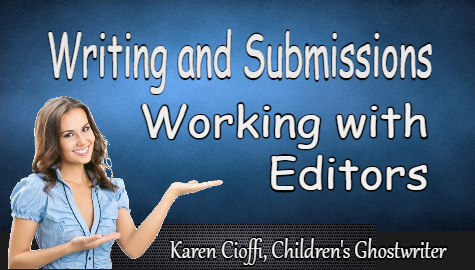Every writer, at least hopefully, will work with an editor from time to time. While, we’d all like it to be on a regular basis, time to time is better than nothing. When in the joyous situation (you’ve gotten something accepted for publication), there are some tips that will help you in your working relationship with an editor.
The first thing, even before you think of submitting your work, is to have your manuscript or article in the best shape possible.
GETTING TO THE POINT OF SUBMISSIONS
1. Be part of a critique group. Every writer needs the extra eyes of writers working in the same genre. Their insights and critiques will prove to be invaluable to you.
2. Revise and self-edit . . . repeat and repeat . . .
3. When you think your manuscript is in perfect shape, send it to a freelance editor. You may think this isn’t necessary, but it is. Ask around for one that comes with recommendations.
Now, you’re set; off you go on your submissions fishing trip. But, don’t just drop the line randomly; be sure you do research and find the best spot – one where you know the fish are biting. What this means is to look for publishing houses that are best suited to your manuscript, and ones that are accepting submissions.
After you’ve found a few publishing houses suitable. Read their submission guidelines CAREFULLY, and follow them just as carefully. Now it’s time for the infamous query letter. If you’re unfamiliar with queries, do some research.
Okay, you’ve done everything you needed to, and now you cast off. AND, you get a bite.
WORKING WITH EDITORS
Once you’re accepted by a publishing house, you will be assigned an editor. And, don’t be alarmed, but that manuscript you meticulously slaved over, and even paid an editor to go over, will end up with revisions. This is just the nature of the beast—each publishing house has their own way of doing things. They will want you’re manuscript to fit their standards.
Note: the purpose of those long hours of writing work, and hiring an editor is to give your manuscript the best shot of making it past the acquisition editor’s trash pile, and actually getting accepted.
Now on to 4 tips that will help make your editor/author experience a pleasant one:
1. Always be professional.
2. Don’t get insulted when the editor requests revisions. They are not trying to hurt your feelings; they are hired by the publishing house to get your manuscript in the best possible saleable state. They want your book to sell as much as you do.
3. Keep the lines of communication open. If you have a question, ask. If you disagree with an edit, respectfully discuss it. Editors are not infallible; sometimes your gut feeling is right.
4. Take note of deadlines and be on time—this is your career, and in some cases your livelihood.
NEED HELP WITH YOUR STORY?
Whether you need help with ghostwriting, rewriting, or coaching, let me take a look at your children’s story. Just send me an email at: kcioffiventrice@gmail.com. Please put “Children’s Writing” in the Subject box. Or, give me a call at 347—834—6700.
Let’s get your idea off the launch pad or your outline into a publishable and marketable story today!
Or, if you’d rather give it a shot and do-it-yourself, check out my book, HOW TO WRITE A CHILDREN’S FICTION BOOK.
MORE ON WRITING FOR CHILDREN
Book Marketing and the Query Letter
Point of View and Children’s Storytelling
Writing for Children – Character Believability and Conflict

Hi, Sharon, yes I do. Please email me if you’d like a post considered.
Karen